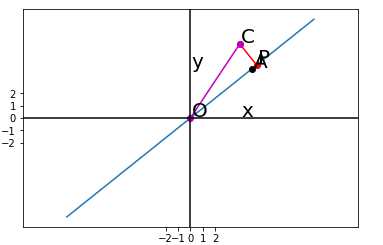标签:one space diff ret fill gate puts 隐藏 shape
import numpy as np from matplotlib import pyplot as plt A = np.array([[5],[4]]) C = np.array([[4],[6]]) B = A.T.dot(C) AA = np.linalg.inv(A.T.dot(A)) l=AA.dot(B) P=A.dot(l) x=np.linspace(-2,2,10) x.shape=(1,10) xx=A.dot(x) fig = plt.figure() ax= fig.add_subplot(111) ax.plot(xx[0,:],xx[1,:]) ax.plot(A[0],A[1],‘ko‘) ax.plot([C[0],P[0]],[C[1],P[1]],‘r-o‘) ax.plot([0,C[0]],[0,C[1]],‘m-o‘) ax.axvline(x=0,color=‘black‘) ax.axhline(y=0,color=‘black‘) margin=0.1 ax.text(A[0]+margin, A[1]+margin, r"A",fontsize=20) ax.text(C[0]+margin, C[1]+margin, r"C",fontsize=20) ax.text(P[0]+margin, P[1]+margin, r"P",fontsize=20) ax.text(0+margin,0+margin,r"O",fontsize=20) ax.text(0+margin,4+margin, r"y",fontsize=20) ax.text(4+margin,0+margin, r"x",fontsize=20) plt.xticks(np.arange(-2,3)) plt.yticks(np.arange(-2,3)) ax.axis(‘equal‘) plt.show()

x = [(2, 0, 3), (1, 0, 3), (1, 1, 3), (1,4, 2), (1, 2, 4)] y = [5, 6, 8, 10, 11] alpha = 0.02 diff = [0, 0] error0 = 0 error1 = 0 w0 = 0 w1 = 0 w2 = 0 cnt = 0 while True: cnt += 1 for i in range(len(x)): diff[0] = (w0 * x[i][0] + w1 * x[i][1] + w2 * x[i][2]) - y[i] w0 -= alpha * diff[0] * x[i][0] w1 -= alpha * diff[0] * x[i][1] w2 -= alpha * diff[0] * x[i][2] error1 = 0 for lp in range(len(x)): error1 += (y[lp] - (w0 + w1 * x[lp][1] + w2 * x[lp][2])) ** 2 / 2 if abs(error1 - error0) < 0.002: break else: error0 = error1 print(‘theta0 : %f, theta1 : %f, theta2 : %f, error1 : %f‘ % (w0, w1, w2, error1)) print(‘Done: theta0 : %f, theta1 : %f, theta2 : %f‘ % (w0, w1, w2)) print(‘迭代次数: %d‘ % cnt)

import math import random import numpy as np def rand(a, b): return (b - a) * random.random() + a def make_matrix(m,n,fill=0.0): mat = [] for i in range(m): mat.append([fill] * n) return mat def sigmoid(x): return 1.0 / (1.0 + math.exp(-x)) def sigmod_derivate(x): return x * (1 - x) class BPNeuralNetwork: def __init__(self): self.input_n = 0 self.hidden_n = 0 self.output_n = 0 self.input_cells = [] self.hidden_cells = [] self.output_cells = [] self.input_weights = [] self.output_weights = [] def setup(self,ni,nh,no): self.input_n = ni + 1 self.hidden_n = nh self.output_n = no self.input_cells = [1.0] * self.input_n self.hidden_cells = [1.0] * self.hidden_n self.output_cells = [1.0] * self.output_n self.input_weights = make_matrix(self.input_n,self.hidden_n) self.output_weights = make_matrix(self.hidden_n,self.output_n) # random activate for i in range(self.input_n): for h in range(self.hidden_n): self.input_weights[i][h] = rand(-0.2, 0.2) for h in range(self.hidden_n): for o in range(self.output_n): self.output_weights[h][o] = rand(-2.0, 2.0) def predict(self,inputs): for i in range(self.input_n - 1): self.input_cells[i] = inputs[i] for j in range(self.hidden_n): total = 0.0 for i in range(self.input_n): total += self.input_cells[i] * self.input_weights[i][j] self.hidden_cells[j] = sigmoid(total) for k in range(self.output_n): total = 0.0 for j in range(self.hidden_n): total += self.hidden_cells[j] * self.output_weights[j][k] self.output_cells[k] = sigmoid(total) return self.output_cells[:] def back_propagate(self,case,label,learn): self.predict(case) #计算输出层的误差 output_deltas = [0.0] * self.output_n for k in range(self.output_n): error = label[k] - self.output_cells[k] output_deltas[k] = sigmod_derivate(self.output_cells[k]) * error #计算隐藏层的误差 hidden_deltas = [0.0] * self.hidden_n for j in range(self.hidden_n): error = 0.0 for k in range(self.output_n): error += output_deltas[k] * self.output_weights[j][k] hidden_deltas[j] = sigmod_derivate(self.hidden_cells[j]) * error #更新输出层权重 for j in range(self.hidden_n): for k in range(self.output_n): self.output_weights[j][k] += learn * output_deltas[k] * self.hidden_cells[j] #更新隐藏层权重 for i in range(self.input_n): for j in range(self.hidden_n): self.input_weights[i][j] += learn * hidden_deltas[j] * self.input_cells[i] error = 0 for o in range(len(label)): error += 0.5 * (label[o] - self.output_cells[o]) ** 2 return error def train(self,cases,labels,limit = 100,learn = 0.05): for i in range(limit): error = 0 for i in range(len(cases)): label = labels[i] case = cases[i] error += self.back_propagate(case, label, learn) pass def test(self): cases = [ [0, 0], [0, 1], [1, 0], [1, 1], ] labels = [[0], [1], [1], [0]] self.setup(2, 5, 1) self.train(cases, labels, 100000, 0.001) for case in cases: print(self.predict(case)) if __name__ == ‘__main__‘: nn = BPNeuralNetwork() nn.test()

标签:one space diff ret fill gate puts 隐藏 shape
原文地址:https://www.cnblogs.com/tszr/p/10357422.html